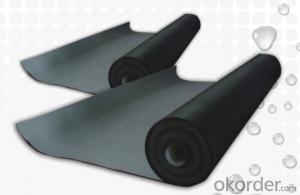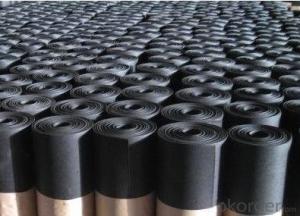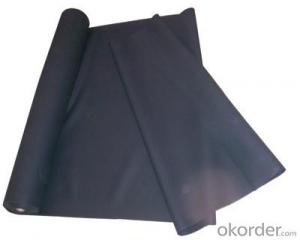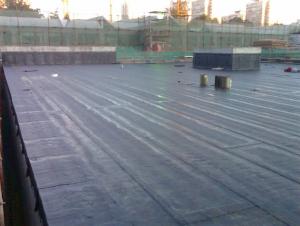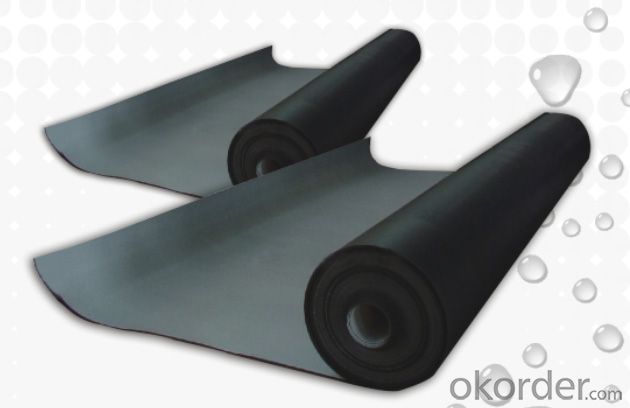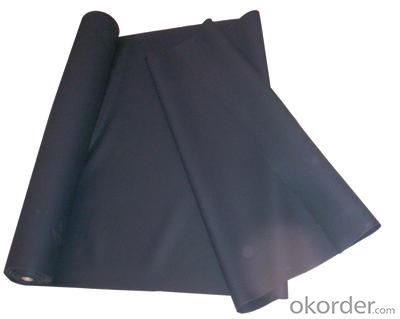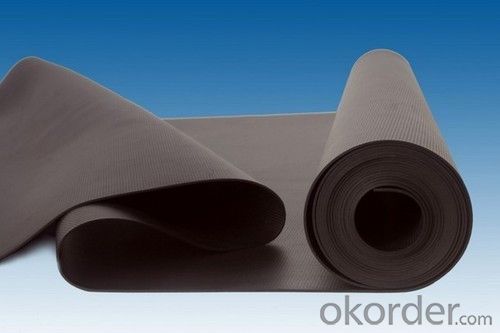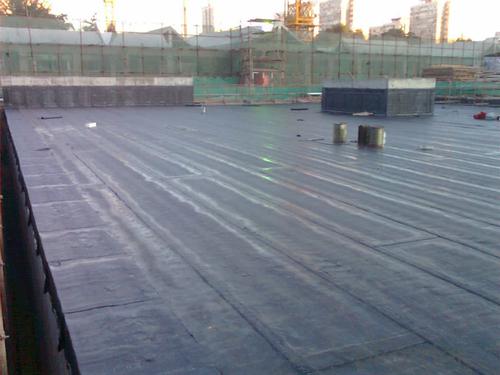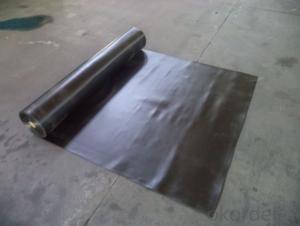EPDM Coiled Rubber Waterproof Membrane with 0.8mm Thickness
- Loading Port:
- Shanghai
- Payment Terms:
- TT OR LC
- Min Order Qty:
- 20000 m²
- Supply Capability:
- 5000000 m²/month
OKorder Service Pledge
OKorder Financial Service
You Might Also Like
EPDM Coiled Rubber Waterproof Membrane with 0.8mm Thickness
Description Of EPDM Coiled Rubber Waterproof Membrane with 0.8mm Thickness:
This waterproof coiled material is of high elasticity with best performance among high polumer
waterproof coiled material in the world.It is also the most typical one in the world.Waterproof coiled material made of ternary ethylene-propylene rubber is produced withthe use of the most advanced contiuous extrusion and vulcanization technology and related equipments which are specially designed for production of such product.It is good in compactness,without bubble and performance difference in length and breadth,perfomances reach or exceedthe demands of GB18173.1-2000 standard.
Main Features of EPDM Coiled Rubber Waterproof Membrane with 0.8mm Thickness:
A.Polyester based SBS Modified Bitumen Waterproofing Membrane
a. Strong impermeability
b. High tensile strength, elongation, ability to adapt the grassroots shrinkage deformation and cracking
c. Puncture-resistant, broken resistant, tear-resistant
d. The corrosion resistance, resistance to mildew, weathering good
e. Construction convenient, hot-melt can be operated Four Seasons Construction, reliable joints
B. Fiberglass based SBS Modified Bitumen Waterproofing Membrane
a. High tensile strength, stability of a good size
b. High Temperature good performance
c. Damage resistance, corrosion resistance, resistance to mildew, weathering good performance
d. Good construction performance, reliable joints.
Specifications of EPDM Coiled Rubber Waterproof Membrane with 0.8mm Thickness:
| Material | EPDM Rubber |
| Size | 1.2m (width)*20m (length) or customized, weldable type 2.05m or 4m width |
| Thick | 1.2mm, 1.5mm, 2.0mm |
| Type | Vulcanized & Weldable |
| Pattern | Non-reinforced (homogeneous) |
| Certificate | ISO9001/14001 |
Applications of EPDM Coiled Rubber Waterproof Membrane with 0.8mm Thickness:
1. Roofs, Basement, Toilet
2. Industrial and civil building waterproofing
3. Geo-synthetic liner for swimming pool, channels, irrigation system
4. Especially suit for projects with high requirements in durability, anti-corrosion and deformation

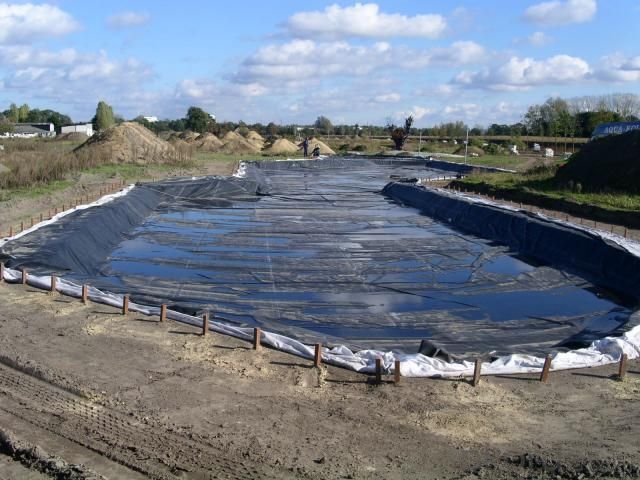

IMages of EPDM Coiled Rubber Waterproof Membrane with 0.8mm Thickness:




FAQ of EPDM Coiled Rubber Waterproof Membrane with 0.8mm Thickness:
1. What are we supplying?
We are specialized in producing Colorful Asphalt Roof Shingle, SBS/APP modified bitumen waterproof membrane, Self adhesive bitumen waterproof membrane, PVC waterproofing membrane, EPDM rubber roofing membrane, Single Component Polyurethane Waterproof Coating, and Spray Polyurea Waterproof Coating
.
2. How Many years experience do we have?
We have been exported to more than 20 countries in the past 15 years.
3. How long do we usually reply your request?
We always reply our customer within 24 hours.
- Q: Are there any environmental considerations when using a waterproofing membrane?
- When using a waterproofing membrane, there are several environmental factors to consider. One major concern is the possibility of harmful chemicals or materials being used during production. Some membranes may contain toxic substances like volatile organic compounds (VOCs) or heavy metals, which can negatively impact both human health and the environment. Another consideration is how to properly dispose of the membrane at the end of its lifespan. Many waterproofing membranes are not biodegradable and can contribute to landfill waste. Incorrect disposal methods can lead to environmental pollution and harm ecosystems. Furthermore, the production of waterproofing membranes often involves energy-intensive processes and the extraction of non-renewable resources. This can result in greenhouse gas emissions and the depletion of natural resources. To address these environmental concerns, it is crucial to select waterproofing membranes that have been made using eco-friendly materials and processes. Look for products labeled as low VOC or free from hazardous substances. Additionally, consider using recyclable membranes or those made from recycled materials to decrease waste generation. Proper disposal of the membrane at the end of its life cycle is also vital, and options such as recycling or repurposing should be explored. In conclusion, it is essential to take the environmental impact of waterproofing membranes into account and choose products and practices that minimize harm to the environment and promote sustainability.
- Q: Can a waterproofing membrane be used on both horizontal and vertical surfaces?
- Yes, a waterproofing membrane can be used on both horizontal and vertical surfaces. Waterproofing membranes are specifically designed to create a barrier against water infiltration, regardless of the orientation of the surface. These membranes are commonly used in various applications, such as roofs, foundations, basements, bathrooms, and swimming pools. They are typically made of materials like bitumen, rubberized asphalt, polyurethane, or PVC, which are highly resistant to water penetration. Whether it is a horizontal surface like a roof or a vertical surface like a wall, a waterproofing membrane can effectively prevent water from seeping through and causing damage. However, it is important to ensure that the membrane is properly installed and adhered to the surface to achieve optimal waterproofing performance.
- Q: Can a waterproofing membrane be used for parking garage ramps and driveways?
- Yes, a waterproofing membrane can be used for parking garage ramps and driveways. It serves as a protective barrier against water infiltration, preventing damage to the underlying structure and extending its lifespan.
- Q: BS waterproofing membrane is modified? There are not a few thick drawings, how to do
- SBS waterproofing membrane is elastomer modified asphalt waterproofing membrane. Performance indicators Implementation of GB 18242-2008.
- Q: Can a waterproofing membrane be applied on top of existing roofing systems?
- Yes, a waterproofing membrane can be applied on top of existing roofing systems. This is a common practice in the roofing industry to enhance the waterproofing capabilities of an existing roof. The application of a waterproofing membrane involves the installation of a layer of material that is designed to prevent water infiltration. This membrane can be made of various materials such as asphalt, rubber, or synthetic materials. Before applying the waterproofing membrane, it is important to assess the condition of the existing roofing system. Any damage or defects should be repaired to ensure a solid foundation for the membrane. Additionally, the surface should be thoroughly cleaned and prepared to ensure proper adhesion of the membrane. Once the surface is ready, the waterproofing membrane can be applied using various methods such as hot-mopping, torching, or adhesive application. The membrane is typically installed in multiple layers to provide additional protection against water penetration. Applying a waterproofing membrane on top of an existing roofing system can provide several benefits. It can extend the lifespan of the roof by preventing water damage and leaks. It can also improve the energy efficiency of the building by reducing heat transfer and minimizing air leakage. Additionally, it can enhance the overall waterproofing capabilities of the roof, protecting the underlying structure from moisture-related issues. It is important to consult with a professional roofing contractor to determine the most suitable waterproofing membrane and installation method for your specific roofing system. They will be able to assess the condition of the existing roof and recommend the best course of action to ensure a successful application of the waterproofing membrane.
- Q: Can a waterproofing membrane be used in conjunction with solar panel installations?
- Yes, a waterproofing membrane can be used in conjunction with solar panel installations. Waterproofing membranes are commonly used to protect roofs and other surfaces from water damage, and they can provide an additional layer of protection for solar panels. This can help to prevent water infiltration and potential damage to the solar panels and their electrical components. Additionally, waterproofing membranes can also help to extend the lifespan of the solar panel system by providing an extra barrier against moisture and other environmental factors.
- Q: Can a waterproofing membrane be used on cinder block surfaces?
- Yes, a waterproofing membrane can be used on cinder block surfaces. Cinder blocks are porous materials that can absorb water, so applying a waterproofing membrane can help prevent moisture from penetrating the surface and causing damage. The membrane acts as a barrier, preventing water from infiltrating the cinder blocks and protecting them from moisture-related issues such as mold, mildew, and deterioration. It is important to properly prepare the cinder block surface before applying the membrane to ensure proper adhesion and effectiveness. Additionally, choosing a waterproofing membrane specifically designed for cinder block surfaces will provide the best results.
- Q: Can a waterproofing membrane be used for a tunnel lining?
- Yes, a waterproofing membrane can be used for a tunnel lining.
- Q: Can a waterproofing membrane be used on tunnels with vehicular traffic?
- Yes, a waterproofing membrane can be used on tunnels with vehicular traffic. Waterproofing membranes are designed to provide a barrier against water infiltration, protecting the structure from potential damage caused by moisture. In tunnels with vehicular traffic, water can seep through the concrete and cause corrosion, deterioration, and even compromise the structural integrity of the tunnel. By applying a waterproofing membrane, it creates a protective layer that prevents water from penetrating the tunnel walls, roof, and floor. This helps to extend the lifespan of the tunnel and ensures the safety of vehicles passing through. However, it is essential to select a waterproofing membrane specifically designed for heavy traffic conditions to withstand the constant load and wear. Additionally, proper installation and regular maintenance are crucial to ensure the effectiveness and longevity of the waterproofing system in tunnels with vehicular traffic.
- Q: Are waterproofing membranes resistant to punctures?
- Waterproofing membranes are created to resist punctures. These membranes are typically constructed from strong materials like polyvinyl chloride (PVC), thermoplastic olefin (TPO), or ethylene propylene diene terpolymer (EPDM), which are renowned for their durability and ability to endure external pressures. Moreover, polyester or fiberglass is often incorporated into the waterproofing membranes to further strengthen their resistance to punctures. Nevertheless, it is crucial to acknowledge that while these membranes are designed to be highly resistant to punctures, they can still be vulnerable to damage if exposed to sharp objects or excessive force. Therefore, it is imperative to handle and install these membranes with caution in order to uphold their integrity and effectiveness.
Send your message to us
EPDM Coiled Rubber Waterproof Membrane with 0.8mm Thickness
- Loading Port:
- Shanghai
- Payment Terms:
- TT OR LC
- Min Order Qty:
- 20000 m²
- Supply Capability:
- 5000000 m²/month
OKorder Service Pledge
OKorder Financial Service
Similar products
Hot products
Hot Searches
Related keywords
